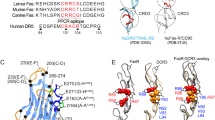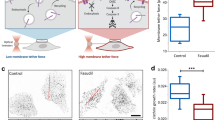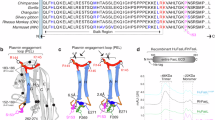Abstract
Expression of apoptosis-related proteins, bcl-2, Bax, Fas and Fas ligand (L), in ovarian epithelial neoplasms together with its clinical relevance was examined by immunohistochemistry. They included 36 cases with adenoma, 33 with low potential malignancy (LPM) and 63 with carcinomas. bcl-2 expression was observed in 14 of 36 cases (39%) with adenoma, five of 33 (15%) with LPM (P< 0.05) and 12 of 63 (19%) with carcinoma (P< 0.05). Cases with bcl-2 expression showed more favourable prognosis than those without, but the difference was not statistically significant. There was no difference in frequency of Bax and Fas expression between each histologic category. Fas L expression was observed in one of 36 cases (3%) with adenoma, but in 12 of 33 (36%) with LPM (P< 0.001) and 42 of 63 (67%) with carcinoma (P< 0.0001). In carcinomas, cases expressing Fas L showed a less favourable prognosis than those without (P= 0.02). Density of CD8+ lymphocytes, possibly cytotoxic T-cells, was higher in serous carcinoma with negative Fas L expression than those with positive Fas L expression. These findings suggest that Fas L expressing carcinomas induce apoptosis in infiltrating CTL with Fas expression, and escape from immune surveillance. © 2000 Cancer Research Campaign
Similar content being viewed by others
Article PDF
Change history
16 November 2011
This paper was modified 12 months after initial publication to switch to Creative Commons licence terms, as noted at publication
References
Armitage BG (1987) Statistical Methods in Medical Research 2nd edn. Blackwell: Oxford
Barber HRK (1993) Ovarian Carcinoma. Etiology, Diagnosis, and Treatment 3rd edn. Springer-Verlag: New York
Bennett MW, O'Connell J, O'Sullivan GC, Brady C, Roche D, Collins JK and Shanahan F (1998) The Fas counterattack in vivo: apoptotic depletion of tumor-infiltrating lymphocytes associated with Fas ligand expression by human esophageal carcinoma. J Immunol 160: 5669–5675
Brambilla E, Negoescu A, Gazzeri S, Lantuejoul S, Moro D, Brambilla C and Coll JL (1996) Apoptosis-related factors p53, Bcl2, and Bax in neuroendocrine lung tumors. Am J Pathol 149: 1941–1952
Brinton LA and Hoover RN (1992) Epidemiology of gynecologic cancers. In: Principles and Practice of Gynecologic Oncology Hoskins WJ, Perez CA, Young RC (eds), pp. 3–26, JB Lippincott: Philadelphia
Garzetti GG, Ciavattini A, Goteri G, Nictolis MD, Stramazzotti D, Lucarini G and Biagini G (1995) Ki67 antigen immunostaining (MIB 1 monoclonal antibody) in serous ovarian tumors: index of proliferative activity with prognostic significance. Gynecol Oncol 56: 169–174
Hahne M, Rimoldi D, Schröter M, Romero P, Schreier M, French LE, Schneider P, Bornand T, Fontana A, Lienard D, Cerottini JC and Tschopp J (1996) Melanoma cell expression of Fas(Apo-1/CD95) ligand: implications for tumor immune escape. Science 274: 1363–1366
Hellquist HB, Olejnicka B, Jadner M, Andersson T and Sederholm C (1997) Fas receptor is expressed in human lung squamous cell carcinomas, whereas bcl-2 and apoptosis are not pronounced: a preliminary report. Br J Cancer 76: 175–179
Henriksen R, Funa K, Wilander E, Bäckström T, Ridderheim M and Öberg K (1993) Expression and prognostic significance of platelet-derived growth factor and its receptors in epithelial ovarian neoplasms. Cancer Res 53: 4550–4554
Henriksen R, Wilander E and Öberg K (1995) Expression and prognostic significance of Bcl-2 in ovarian tumours. Br J Cancer 72: 1324–1329
Hockenbery D, Nuñez G, Milliman C, Shreiber RD and Korsmeyer SJ (1990) Bcl-2 is an inner mitochondrial membrane protein that blocks programmed cell death. Nature 348: 334–336
Hoehner JC, Gestblom C, Olsen L and Påhlman S (1997) Spatial association of apoptosis-related gene expression and cellular death in clinical neuroblastoma. Br J Cancer 75: 1185–1194
Hughes SJ, Nambu Y, Soldes OS, Hamstra D, Rehemtulla A, Iannettoni MD, Orringer MB and Beer DG (1997) Fas/APO-1 (CD95) is not translocated to the cell membrane in esophageal adenocarcinoma. Cancer Res 57: 5571–5578
Joensuu H, Pylkkänen L and Toikkanen S (1994) Bcl-2 protein expression and long-term survival in breast cancer. Am J Pathol 145: 1191–1198
Kaplan EL and Meier P (1958) Non-parametric estimation from incomplete observations. J Am Stat Ass 53: 457–481
Katsube Y, Berg JW and Silverberg SG (1982) Epidemiologic pathology of ovarian tumors: a histopathologic review of primary ovarian neoplasms diagnosed in the Denver Standard Metropolitan Statistical Area, 1 July–31 December 1969 and 1 July–31 December 1979. Int J Gynecol Pathol 1: 3–16
Koonings PP, Campbell K, Mishell DR and Grimes DA (1989) Relative frequency of primary ovarian neoplasms: a 10-year review. Obstet Gynecol 74: 921–926
Landowski TH, Qu N, Buyuksal I, Painter JS and Dalton WS (1997) Mutations in the Fas antigen in patients with multiple myeloma. Blood 90: 4266–4270
McDonnell TJ, Deane N, Platt FM, Nunez G, Jaeger U, Mckearn JP and Korsmeyer SJ (1989) Bcl-2 immunoglobulin transgenic mice demonstrate extended B cell survival and follicular lymphoproliferation. Cell 57: 79–88
Müllauer L, Mosberger I and Chott A (1998) Fas ligand expression in nodal non-Hodgkin's lymphoma. Mod Pathol 11: 369–375
Nagata S and Golstein P (1995) The Fas death factor. Science 267: 1449–1456
Niehans GA, Brunner T, Frizelle SP, Liston JC, Salerno CT, Knapp DJ, Green DR and Kratzke RA (1997) Human lung carcinomas express Fas ligand. Cancer Res 57: 1007–1012
Oltvai ZN, Milliman CL and Korsmeyer SJ (1993) Bcl-2 heterodimerizes in vivo with a conserved homolog, Bax, that accelerates programmed cell death. Cell 74: 609–619
Omura GA, Brady MF, Homesley HD, Yordan E, Major FJ, Buchsbaum HJ and Park RC (1991) Long-term follow-up and prognostic factor analysis in advanced ovarian carcinoma: the Gynecologic Oncology Group experience. J Clin Oncol 9: 1138–1150
Owen-Schaub LB, Radinsky R, Kruzel E, Berry K and Yonehara S (1994) Anti-Fas on nonhematopoietic tumors: levels of Fas/APO-1 and bcl-2 are not predictive of biological responsiveness. Cancer Res 54: 1580–1586
Pezella F, Turley H, Kuzu I, Tungekar MF, Dunnill MS, Pierce CB, Harris A, Gatter KC and Mason DY (1993) Bcl-2 protein in non-small cell lung carcinoma. N Engl J Med 329: 690–694
Rodenburg CJ, Cornelisse CJ, Heintz PAM, Hermans JO and Fleuren GJ (1987) Tumor ploidy as a major prognostic factor in advanced ovarian cancer. Cancer 59: 317–323
Shima Y, Nishimoto N, Ogata A, Fujii Y, Yoshizaki K and Kishimoto T (1995) Myeloma cells express Fas antigen/APO-1 (CD95) but only some are sensitive to anti-Fas antibody resulting in apoptosis. Blood 85: 757–764
Shiraki K, Tsuji N, Shioda T, Isselbacher KJ and Takahashi H (1997) Expression of Fas ligand in liver metastases of human colonic adenocarcinomas. Proc Natl Acad Sci USA 94: 6420–6425
Slamon DJ, Godolphin W, Jones LA, Holt JA, Wong SG, Keith DE, Levin WJ, Stuart SG, Udove J, Ullrich A and Press MF (1989) Studies of the HER-2/neu proto-oncogene in human breast and ovarian cancer. Science 244: 707–712
Strand S, Hofmann WJ, Hug H, Müller M, Otto G, Strand D, Mariani SM, Stremmel W, Krammer PH and Galle PR (1996) Lymphocyte apoptosis induced by CD95 (APO-1/Fas) ligand-expressing tumor cells – a mechanism of immune evasion?. Nature Med 2: 1361–1366
Takahashi T, Tanaka M, Inazawa J, Abe T, Suda T and Nagata S (1994) Human Fas ligand: gene structure, chromosomal location and species specificity. Int Immunol 6: 1567–1574
Tanaka M, Suda T, Haze K, Nakamura N, Sato K, Kimura F, Motoyoshi K, Mizuki M, Tagawa S, Ohga S, Hatake K, Drummond AH and Nagata S (1996) Fas ligand in human serum. Nat Med 2: 317–322
Ungefroren H, Voss M, Jansen M, Roeder C, Henne-Bruns D, Kremer B and Kalthoff H (1998) Human pancreatic adenocarcinomas express Fas and Fas ligand yet are resistant to Fas-mediated apoptosis. Cancer Res 58: 1741–1749
Wakahara Y, Nawa A, Okamoto T, Hayakawa A, Kikkawa F, Suganuma N, Wakahara F and Tomoda Y (1997) Combination effect of anti-Fas antibody and chemotherapeutic drugs in ovarian cancer cells in vitro. Oncology 54: 48–54
Wehrli BM, Krajewski S, Gascoyne RD, Reed JC and Gilks CB (1998) Immunohistochemical analysis of bcl-2, bax, mcl-1, and bcl-X expression in ovarian surface epithelial tumors. Int J Gynecol Pathol 17: 255–260
Author information
Authors and Affiliations
Rights and permissions
From twelve months after its original publication, this work is licensed under the Creative Commons Attribution-NonCommercial-Share Alike 3.0 Unported License. To view a copy of this license, visit http://creativecommons.org/licenses/by-nc-sa/3.0/
About this article
Cite this article
Munakata, S., Enomoto, T., Tsujimoto, M. et al. Expressions of Fas ligand and other apoptosis-related genes and their prognostic significance in epithelial ovarian neoplasms. Br J Cancer 82, 1446–1452 (2000). https://doi.org/10.1054/bjoc.1999.1073
Received:
Revised:
Accepted:
Published:
Issue date:
DOI: https://doi.org/10.1054/bjoc.1999.1073
Keywords
This article is cited by
-
Candidate protein biomarkers in pancreatic neuroendocrine neoplasms grade 3
Scientific Reports (2020)
-
The role of CD95 and CD95 ligand in cancer
Cell Death & Differentiation (2015)
-
Corticotropin-releasing hormone (CRH) is expressed in the human cervical carcinoma cells (HeLa) and upregulates the expression of Fas ligand
Tumor Biology (2013)
-
Weapons Ovarian Epithelial Tumors May Use in Immune Escape: An Immunohistochemical Correlational Study
Pathology & Oncology Research (2012)
-
Differential expression of Fas family members and Bcl-2 family members in benign versus malignant epithelial ovarian cancer (EOC) in North Indian population
Molecular and Cellular Biochemistry (2012)



